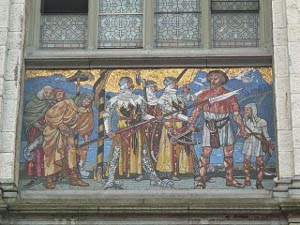 Museum courtyard
the loss.
Museum courtyard
the loss.
After so many days of cloud-covered skies and wet pavements, we especially enjoyed the bright blue sky and mild temperature of Zurich.
In the morning we headed for the Swiss National Museum, which had a special four-month exhibit of Leonardo da Vinci. After so many Leonardo sightings in Europe we were hoping it would provide fresh understanding. Unfortunately it did not; but the remainder of the Museum more than made up for  Museum courtyard
the loss.
Museum courtyard
the loss.
As far as Leonardo's art works are concerned, there are only four major works which can definitely be identified as his own. He himself served as an apprentice to an artistic master, and later established his own school, filled with apprentices. Works were often identified by the school and not the individual artist.
His notebooks are tiny little objects, filled with his tiny script -- probably the densest ratio of creative ideas to pages that ever existed. As we learned in Milan, they are held in libraries around the world.
This exhibit consisted mainly of replicas of his drawings and notebooks, modern models built from his designs, and works of artists who followed his creative lead. In addition there were several minor works identified as definitely done by Leonardo, and several more minor works attributed to him.
There was an oddity: a picture of a man's head made out of penises, entitled Phallic Head. It reminded us of the Arcimbaldo paintings of heads made out of flowers or grains. What would Freud have made of it?
The exhibits filled eight or ten rooms, and had captions in German and English. But we gained no new understanding of this great thinker. Each generation needs to learn of da Vinci's genius, and this exhibition provided a coherent perspective for the crowds of Swiss museum-goers that filled the halls.
 Courtyard - another view
Courtyard - another view
This museum is housed in a beautiful old building across the street from the railroad station in downtown Zurich. It's a three story building, but there are many split levels and half-staircases, so one is constantly mounting or descending to view the exhibits.
The theme of the museum is Swiss history. Rotating explanatory stands are being placed in the museum, with captions in German, French, Italian and English on the four sides. This project is about 75% finished; the remaining 25% of the time we struggled with the German captions.
We began our tour with a fascinating archaeological exhibit which traced man's presence in this area from Neanderthal times (bones, primitive tools) through the bronze and iron ages and well into recorded history, finishing with a timeline of the rise and collapse of the Celtic and Roman occupations.
Part of the fascination lies in the excellent condition of the artifacts, many of which have been preserved in this damp and peat-filled area. Another part lies in the way the archaeologists have added to the understanding of historians; the written records tend to be limited to formal and official events. Yet another part lies in the interpretation of objects placed in graves or otherwise venerated: trying to guess a system of beliefs without a written record is daunting.
Some of the earliest and most important historical records and artifacts are religious. The Romans wiped out the Celtic druids, who practiced human sacrifice, but accepted the Celtic gods into the Roman pantheon, as was their custom. Christianity was introduced early, and churches and monasteries were built. Later, Switzerland was heavily involved in the Reformation. Some of the early works of religious art that were removed by the Protestants have found their way to the museum.
We wish we could have photographed some of these altar pieces: carved and painted wooden sculpture with religious themes, placed inside doors which were  Exterio fresco
only opened to the congregation on festival days. The later limewood sculptures were so exquisitely carved that they were not painted, just kept polished.
Exterio fresco
only opened to the congregation on festival days. The later limewood sculptures were so exquisitely carved that they were not painted, just kept polished.
Later galleries detailed the ever incomprehensible series of wars that raged over Europe for centuries, at least insofar as they concerned Switzerland. The Swiss provided mercenaries for many of these wars. It was generally a profitable business, but few returned from the Napoleonic campaign in the East. Swiss guards still form the ceremonial troops for the Vatican.
The museum contains entire rooms of furniture (like the Tyrolean museum in Innsbruck), decorative pieces, clothing, weapons and armor, maps and clockwork, coins and official seals. All of these tell the story of this remarkable confederation.
Even today the Swiss federal government provides very limited public services such as military and foreign affairs, customs, coinage, and postal service. The remainder of government is left to the individual cantons and cities.
We were ready to leave when an eager staffer pointed us to the new displays of bookbinding and shoemaking in the basement, and the recent history on the top floor, where we saw architects models of proposed expansions for the museum.
We think this is a must-see attraction for visitors to Zurich and a worthwhile contrast to the shopping streets and lakeside views.
We made one last trip -- to the internet cafe at the railroad station which provides an ethernet connection for laptops. (We were still unable to get hooked up to the net on this hotel's phone lines.)